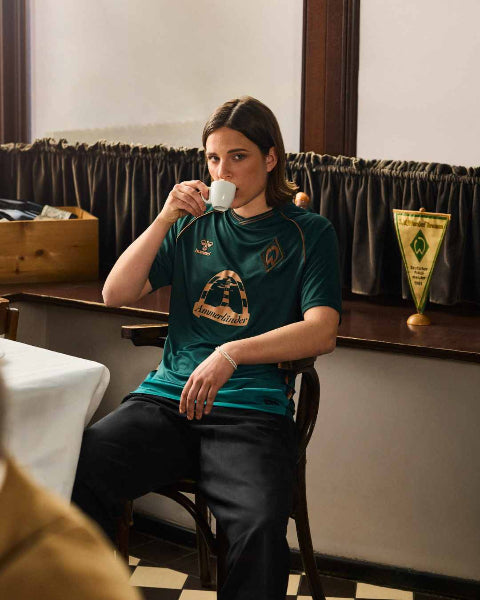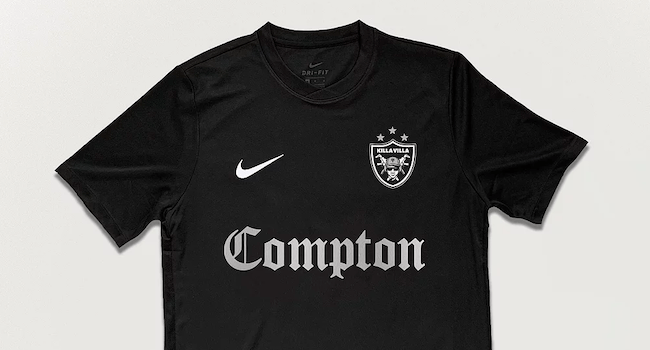Recently added
Vintage shirts
Concept kits
Legends
How to wash football shirts
by Phil Delves February 05, 2022 5 min read

All shirt collectors will have to wash their football shirts at some point or another.
Even if you're one of those collectors who buys a kit and then stashes it away neatly in a cupboard like a prized stamp, you'll eventually win an auction on eBay and be met with an unpleasant, indistinguishable smell as soon as you open the plastic delivery bag.
Collectors Club Blogs
| Storing shirts | Displaying shirts | Selling shirts | Photographing shirts |
For other collectors who wear their shirts (apparently that's what they're supposed to be used for!?), a wash is a natural part of the cycle (hopefully).
The problem is, football shirts behave differently than other types of clothing. They're more fragile, they do weird things around heat, and ultimately they're more valuable than just your average t-shirt. Washing a football shirt can be a stressful undertaking, no matter the age or rarity of the kit, especially if you want to know can they go in a dryer or not.
For this edition of Collectors Club, we're looking at the seemingly humble topic of washing that has the potential to ruin the lives of even the most seasoned shirt fanatic. Helping us today are Roger from Cult Football and Asa from Football Creations & Restorations, two guys who’ve washed a kit or two in their time.
How do you wash football shirts?
1. Separate, inside out, cold
Three key principles will get you very far when it comes to washing shirts; separate, turning inside out and washing cold.
Separate colours as best you can, which for most of us would be lights and darks (unless your collection has a particularly high number of red shirts!). It’s also worth washing your shirts inside out, and importantly when using a washing machine you want to wash on a relatively cold cycle.
Shirt care labels (the ones with all the symbols on) should give recommendations as to temperature, but there’s usually a fair amount of leeway so long as you’re on the colder end of the spectrum.
Roger: For the vast majority of shirts I would separate colours and machine wash inside out on a cold cycle, whilst always avoiding fabric softener.
2. If in doubt, handwash
Although the majority of shirts can be safely washed in a machine, you also have the option of a handwash for those particularly delicate or rare shirts where you don’t want to leave anything to chance.
Any shirts which have particularly fragile sponsors should also be considered for a handwash.
Asa: I’ve got a dedicated black linen bag marked “football shirts”. The wife is instructed to never touch it. And once a suitable amount of shirts have built up in the pouch I give them a loving handwash in the bath.
Roger: Anything really old or with the potential to cause damage (plastic sponsors etc.) I would hand wash in cold/cool water using delicates hand wash cleaning products. check for any damage big or small before washing. If sponsors and prints look delicate, slightly peeled etc don’t take risks.
3. Printing doesn’t change things when it comes to washing
There’s nothing to fear with printing. If your shirts have names and/or numbers, follow the same advice above with confidence.
That being said, newer shirts with plastic-based applications should be treated the same as some sponsors. If it’s beginning to fall apart, consider handwashing to avoid further damage. Older style flocking should be more durable, but again don’t leave anything to chance and handwash if it is beginning to come off in any way.
Asa: I treat them the same as shirts without printing.
Roger: Nearly all printed shirts should be able to be washed keeping the prints intact.
The newer shirts are a little different as the materials used can be different to the flock style older printing we tend to deal with, personally I haven’t had any problems machine washing printed shirts using cold/cool settings but if anyone wants to make sure or be extra safe i’d recommend hand washing in cool/cold water.
How to remove stains from football shirts?
4. If stains are stubborn, attack them with the right product
Stains are a collectors worst nightmare (especially if you support Spurs or Real Madrid!), but thankfully you do have options at your disposal.
There are a range of specialist product, including sprays which can be applied directly onto the stain and powders which can be added to a bucket/bath whilst soaking the shirts.
Asa: I leave to soak in a dedicated football shirt bucket (how OTT do I sound!?). I tend to soak them in a stain remover for an hour or 2. Longer if it’s an actual stain.
Roger: People tend to give up on stains quite easily without trying specialist cleaning products. Some tend to be more stubborn than others but we tend to use something like a pretreat oxi action stain remover spray.
Of course, there are some stains which are virtually impossible to remove. Classic worst offenders including, paint, oil or even a particularly stubborn signature!
Asa: I’m in the middle of removing 15 autographs from a Merthyr shirt and only 1 is left slightly visible so I’m pretty confident when it comes to getting things out of shirts.
Roger: Oil is probably the worst possible stain to remove and not forgetting paint, it seems everybody’s dad painted in their old football shirts back in the 90s!
Reply with your worst washing machine horror stories. 🙈 pic.twitter.com/AviZhjlPTm
— Football Shirt Collective (@thefootballsc) August 3, 2020
5. Dry naturally if you can, or tumble dryer with great care
Tumble dryers are even riskier than washing machines, so whilst it’s possible to dry most shirts in a dryer on the most appropriate delicate setting, it’s generally advisable to dry in natural conditions if possible. Some collectors wouldn’t even dream of going near a tumble dryer with their shirts though!
As another bonus when it comes to drying naturally, most shirts (especially more modern ones) will dry very quickly due on a washing line or clothes rack to the nature of their materials.
Avoid drying directly on radiators as sponsors and printing can very easily melt.
Asa: I dry my shirts on the washing line, it’s always good to give them an airing
I never tumble dry shirts. Heat is how most of the detailing goes on so the last thing you want to do is undo that process with heat again.
Roger: Usually I would use a dryer for most shirts on a delicate setting keeping certain types of colours together. But again with older and printed shirts I would try to dry in natural conditions.
6. Never wash match worn shirts
If you’re lucky enough to own a match worn shirt, please disregard this entire article.
Match worn shirts, no matter how stained or smell they might be, are worth more the closer to their original condition they are. It might be tempting to try and remove a stain, but they can be used to help verify the authenticity of a kit.
Asa: I wouldn’t wash anything matchworn, keep those marks from the hallowed turf on there!
Roger: The only I don’t personally wash are match worn shirts. Stains and marks on the shirts are a great way to show markings from the games they were worn in plus these marks only add to the speciality of the item.
So there we have it guys. Washing shirts needn’t be a worrying task, and if in doubt it’s always better to be safe than sorry.
Thanks again to Roger and Asa for taking the time to help us out as we look to wash football shirts in the best possible way! If you enjoyed this article stay tuned as we seek to answer more big questions, covering everything from fakes to storing to buying shirts.
If you enjoyed this blog on ... then why not sign-up to our weekly Collectors Clun Newsletter to recieve more great tips each week? You can sign-up here.
Phil Delves
As Head of Content, Phil is the creative playmaker of the team, covering every angle of football shirt news in our blogs and weekly Newsletter. Whether it's telling your fakes from your authentics, or deep dives into the newest football shirts designs, Phil will have all your football shirt content needs covered.
Sidebar
- Premier League football shirts
-
Other English clubs
- Birmingham City
- Blackburn Rovers
- Charlton Athletic
- Coventry City
- Derby County
- Hull City
- Ipswich Town
- Leicester City
- Middlesbrough
- Millwall
- Norwich City
- Portsmouth
- Preston North End
- Queens Park Rangers
- Sheffield United
- Sheffield Wednesday
- Southampton
- Stoke City
- Swansea City
- Watford
- West Bromwich Albion
- Scottish clubs
- Italian club shirts
- Spanish club shirts
- German club shirts
- International
- French club shirts
- Rest of the world
-
Legends
- Adriano
- Alessandro Del Piero
- Andrey Arshavin
- Alvaro Recoba
- Bobby Moore
- Bryan Robson
- Bukayo Saka
- Clarence Seedorf
- Cristian Vieri
- Cristiano Ronaldo
- David Beckham
- David James
- David Seaman
- David Ginola
- Dennis Wise
- Dennis Bergkamp
- Didier Drogba
- Dimitar Berbatov
- Diego Maradona
- Edgar Davids
- Eric Cantona
- Fernando Torres
- Freddie Ljungberg
- Gabriel Batistuta
- Gianluca Vialli
- Gianluigi Buffon
- Giovanni Elber
- Frank Lampard
- Francecso Totti
- Haaland
- Harry Kane
- Hidetoshi Nakata
- Ian Wright
- Jari Litmanen
- Ji Sung Park
- Juninho
- Jurgen Klinsmann
- Kaka
- Landon Donovan
- Lionel Messi
- Lothar Mattaus
- Luis Figo
- Mark Viduka
- Matt Le Tissier
- Mesut Özil
- Michael Owen
- Mikel Arteta
- Neymar
- Nicolas Anelka
- Nwankwo Kanu
- Paolo Di Canio
- Paolo Maldini
- Patrick Vieira
- Rafael Van der Vaart
- Raul
- Riquelme
- Rivaldo
- Robert Pires
- Roberto Baggio
- Robbie Fowler
- Ronaldo Nazario
- Ronaldinho
- Roy Keane
- Rudi Voller
- Ruud Gullit
- Ryan Giggs
- Santi Carzola
- Steve Bull
- Steven Gerrard
- Teddy Sheringham
- Thierry Henry
- Tony Adams
- Toto Schillaci
- Tugay
- Wayne Rooney
- Xabi Alonso
- Zinedine Zidane
- Zola
- Brands
Subscribe
Sign up to get the latest on sales, new releases and more …













